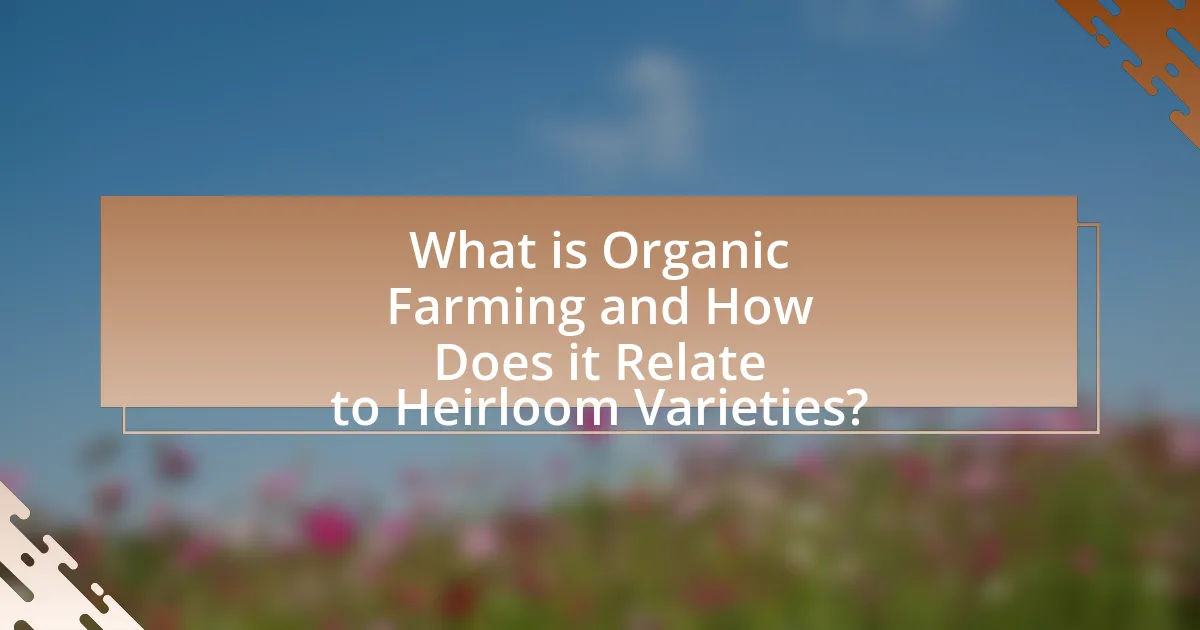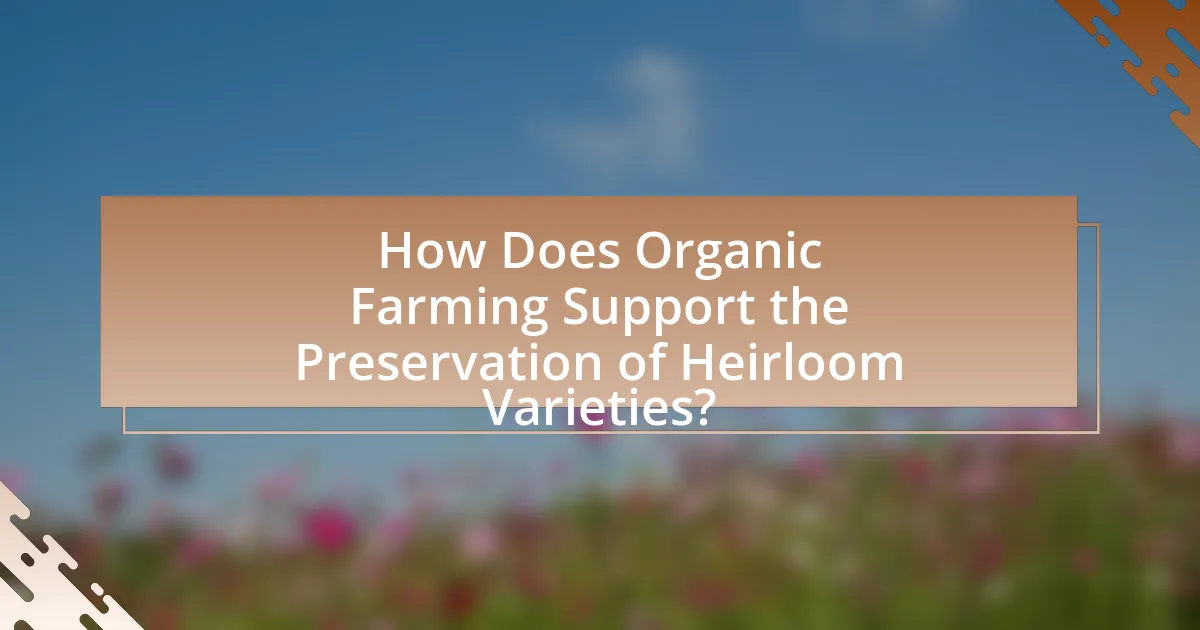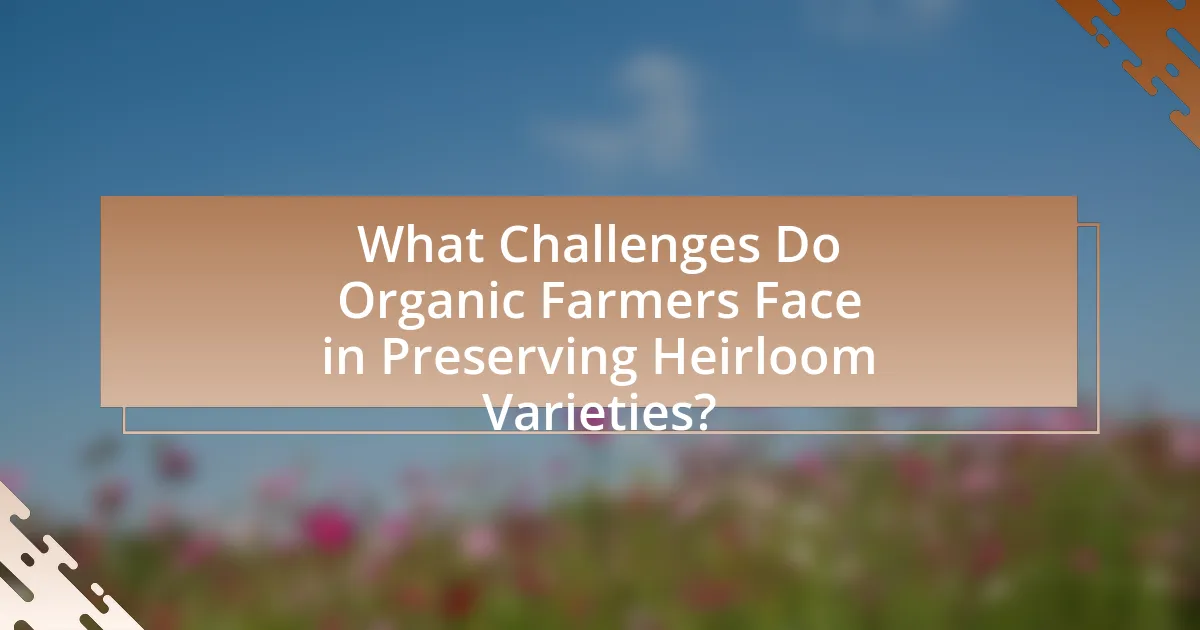Organic farming is an agricultural practice that prioritizes natural processes and materials, avoiding synthetic inputs, and is closely linked to the preservation of heirloom varieties—traditional plant cultivars known for their unique flavors and resilience. This article explores the significance of organic farming for sustainable agriculture, highlighting its role in enhancing soil health, promoting biodiversity, and supporting food security through the cultivation of heirloom varieties. Key principles of organic farming, such as crop rotation and natural pest management, are discussed, along with the challenges organic farmers face in preserving heirloom crops, including market demand and seed availability. The article also outlines strategies for promoting heirloom varieties and the importance of community support in their preservation.

What is Organic Farming and How Does it Relate to Heirloom Varieties?
Organic farming is an agricultural method that emphasizes the use of natural processes and materials, avoiding synthetic fertilizers and pesticides. This approach is closely related to heirloom varieties, which are traditional plant cultivars that have been preserved and passed down through generations, often due to their unique flavors, resilience, and biodiversity. Heirloom varieties thrive in organic farming systems because they are typically well-adapted to local conditions and promote ecological balance, aligning with organic principles that prioritize sustainability and environmental health. Studies show that organic farming can enhance the genetic diversity of heirloom crops, contributing to food security and resilience against pests and diseases.
Why is Organic Farming Important for Sustainable Agriculture?
Organic farming is important for sustainable agriculture because it promotes biodiversity, enhances soil health, and reduces reliance on synthetic chemicals. By utilizing practices such as crop rotation, cover cropping, and organic fertilizers, organic farming improves soil structure and fertility, which leads to increased resilience against pests and diseases. According to the Rodale Institute, organic farming can sequester carbon in the soil, contributing to climate change mitigation. Furthermore, organic methods support the preservation of heirloom varieties, which are crucial for maintaining genetic diversity in crops, thereby ensuring food security and adaptability to changing environmental conditions.
What are the key principles of organic farming?
The key principles of organic farming include the use of natural inputs, crop rotation, biodiversity, and soil health management. Organic farming emphasizes the avoidance of synthetic fertilizers and pesticides, relying instead on organic matter and natural pest control methods to maintain ecosystem balance. Crop rotation helps prevent soil depletion and pest buildup, while promoting biodiversity enhances resilience against diseases. Soil health management focuses on maintaining soil fertility through practices like composting and cover cropping, which contribute to sustainable agricultural systems. These principles are supported by research indicating that organic farming can lead to improved soil quality and increased biodiversity, ultimately benefiting both the environment and food production.
How does organic farming impact soil health?
Organic farming significantly enhances soil health by promoting biodiversity, improving soil structure, and increasing organic matter content. This farming method utilizes natural fertilizers, such as compost and manure, which enrich the soil with essential nutrients and microorganisms. Research indicates that organic farming practices can lead to a 30% increase in soil organic carbon compared to conventional methods, which is crucial for soil fertility and water retention. Additionally, organic farming reduces soil erosion and compaction, fostering a healthier ecosystem that supports various plant and animal life.
What are Heirloom Varieties and Why are They Significant?
Heirloom varieties are traditional plant cultivars that have been passed down through generations, often characterized by their unique flavors, colors, and resilience. These varieties are significant because they contribute to biodiversity, preserve genetic traits that may be lost in commercial hybrids, and support sustainable agriculture practices. For instance, heirloom tomatoes, such as Brandywine and Cherokee Purple, are known for their rich taste and adaptability to local growing conditions, which can enhance food security and promote local ecosystems. Additionally, heirloom varieties often require fewer chemical inputs, aligning with organic farming principles and fostering a healthier environment.
How do heirloom varieties differ from hybrid varieties?
Heirloom varieties differ from hybrid varieties primarily in their genetic makeup and breeding processes. Heirloom varieties are open-pollinated, meaning they can reproduce true to type from their seeds, often passed down through generations, and typically exhibit greater genetic diversity. In contrast, hybrid varieties result from controlled cross-pollination between two different parent plants, designed to produce specific traits such as higher yield or disease resistance, but they do not reliably produce seeds that will grow into the same plant in subsequent generations. This distinction is significant as heirloom varieties often retain unique flavors and characteristics that are lost in hybrids, which are bred for uniformity and commercial viability.
What historical significance do heirloom varieties hold?
Heirloom varieties hold historical significance as they represent the genetic diversity and agricultural practices of past generations. These varieties have been cultivated and passed down through families and communities, often for their unique flavors, resilience, and adaptability to local conditions. For example, many heirloom tomatoes, such as the Brandywine, have been grown since the 19th century and are valued for their taste and heritage. Their preservation is crucial for maintaining biodiversity in agriculture, as they provide essential traits that can be used in breeding programs to develop new varieties that can withstand climate change and pests.

How Does Organic Farming Support the Preservation of Heirloom Varieties?
Organic farming supports the preservation of heirloom varieties by promoting biodiversity and sustainable agricultural practices. Heirloom varieties, which are traditional plant cultivars passed down through generations, thrive in organic systems that avoid synthetic pesticides and fertilizers, allowing for natural selection and adaptation. Research indicates that organic farming practices enhance soil health and ecosystem resilience, which are critical for maintaining the genetic diversity of heirloom crops. For instance, a study published in the journal “Agriculture, Ecosystems & Environment” found that organic farms harbor a greater variety of plant species compared to conventional farms, thereby supporting the cultivation and preservation of heirloom varieties.
What practices in organic farming promote heirloom variety cultivation?
Organic farming practices that promote heirloom variety cultivation include seed saving, crop rotation, and organic pest management. Seed saving allows farmers to preserve and propagate heirloom varieties, ensuring genetic diversity and resilience. Crop rotation enhances soil health and reduces disease pressure, which benefits heirloom plants that may be more susceptible to pests and diseases. Organic pest management techniques, such as using beneficial insects and natural repellents, help maintain the integrity of heirloom varieties without the use of synthetic chemicals. These practices collectively support the sustainability and continuation of heirloom varieties in agricultural systems.
How does crop rotation benefit heirloom varieties?
Crop rotation benefits heirloom varieties by enhancing soil health and reducing pest and disease pressure. This agricultural practice involves alternating different crops in a specific sequence over time, which helps maintain nutrient balance in the soil and prevents the depletion of specific nutrients that certain heirloom varieties may require. For instance, legumes can fix nitrogen in the soil, benefiting subsequent crops. Additionally, rotating crops disrupts the life cycles of pests and diseases that may target specific heirloom varieties, leading to healthier plants and potentially higher yields. Research indicates that diverse cropping systems, including crop rotation, can improve biodiversity and resilience in agricultural ecosystems, which is crucial for the preservation of heirloom varieties.
What role does biodiversity play in organic farming?
Biodiversity plays a crucial role in organic farming by enhancing ecosystem resilience, improving soil health, and promoting pest control. Diverse plant and animal species contribute to a balanced ecosystem, which helps in maintaining soil fertility through varied root structures and organic matter contributions. Additionally, a wide range of species can attract beneficial insects and natural predators, reducing the need for chemical pesticides. Research indicates that farms with higher biodiversity can yield better crop performance and stability, as seen in studies showing that polycultures outperform monocultures in terms of productivity and sustainability.
Why is the preservation of heirloom varieties crucial for food security?
The preservation of heirloom varieties is crucial for food security because these varieties contribute to agricultural biodiversity, which enhances resilience against pests, diseases, and climate change. Heirloom varieties often possess unique traits that can be vital for adapting to changing environmental conditions, ensuring a stable food supply. For instance, a study published in the journal “Agriculture, Ecosystems & Environment” highlights that diverse crop genetic resources can improve yield stability and reduce reliance on chemical inputs, thereby supporting sustainable farming practices. By maintaining a wide range of heirloom varieties, farmers can safeguard against crop failures and ensure a more secure food system.
How do heirloom varieties contribute to genetic diversity?
Heirloom varieties contribute to genetic diversity by preserving a wide range of genetic traits that are not found in modern hybrids. These varieties have been cultivated over generations, often in specific regions, leading to unique adaptations and resilience to local environmental conditions. For example, heirloom tomatoes exhibit diverse colors, shapes, and flavors, which are the result of their varied genetic backgrounds. This genetic diversity is crucial for breeding programs, as it provides a reservoir of traits that can be utilized to improve disease resistance, drought tolerance, and overall adaptability in changing climates. Studies have shown that maintaining a diverse gene pool through heirloom varieties can enhance agricultural sustainability and food security, as it allows for greater adaptability to pests and diseases.
What are the potential risks of losing heirloom varieties?
The potential risks of losing heirloom varieties include decreased biodiversity, loss of unique flavors and nutritional profiles, and increased vulnerability to pests and diseases. Biodiversity is crucial for ecosystem resilience; when heirloom varieties disappear, the genetic diversity within crops diminishes, making agricultural systems more susceptible to environmental changes and threats. Additionally, heirloom varieties often possess distinct flavors and nutritional benefits that are not found in commercial hybrids, which can lead to a less diverse diet and reduced food quality. Furthermore, the loss of these varieties can result in a reliance on a limited number of crops, increasing the risk of widespread crop failure due to pests or diseases that can affect those specific varieties.

What Challenges Do Organic Farmers Face in Preserving Heirloom Varieties?
Organic farmers face significant challenges in preserving heirloom varieties, primarily due to issues such as seed availability, genetic diversity loss, and market demand. The limited availability of heirloom seeds can hinder farmers’ ability to cultivate these varieties, as many commercial seed suppliers focus on hybrid or genetically modified options. Additionally, the genetic diversity of heirloom crops is at risk due to climate change and industrial agriculture practices, which can lead to the extinction of certain varieties. Market demand also poses a challenge; while there is a growing interest in heirloom produce, it often competes with the more uniform and visually appealing commercial varieties, making it difficult for organic farmers to sell heirloom crops at profitable prices. These factors collectively threaten the sustainability of heirloom varieties within organic farming systems.
What are the economic challenges associated with organic farming of heirloom varieties?
The economic challenges associated with organic farming of heirloom varieties include higher production costs, limited market access, and lower yields compared to conventional farming. Organic farming typically requires more labor-intensive practices and organic inputs, which can increase overall expenses. Additionally, heirloom varieties often have niche markets, making it difficult for farmers to find buyers, thus limiting their revenue potential. Research indicates that heirloom crops may yield less than hybrid varieties, which can further impact profitability. For instance, a study published in the Journal of Sustainable Agriculture found that organic heirloom tomatoes produced 20-30% less than conventional hybrids, emphasizing the economic trade-offs involved.
How do market demands affect heirloom variety cultivation?
Market demands significantly influence heirloom variety cultivation by dictating which varieties are grown based on consumer preferences for taste, quality, and uniqueness. Farmers often respond to market trends that favor heirloom varieties due to their perceived superior flavor and nutritional value, leading to increased cultivation of these crops. For instance, a study by the University of California found that heirloom tomatoes, which are sought after for their diverse flavors, have seen a rise in production as consumer interest in local and organic foods has grown. This shift in demand encourages farmers to prioritize heirloom varieties, thereby promoting biodiversity and preserving traditional agricultural practices.
What financial support is available for organic farmers?
Organic farmers can access various financial support options, including government grants, loans, and cost-share programs. In the United States, the USDA offers the Organic Certification Cost Share Program, which reimburses farmers for certification expenses, covering up to 75% of the costs. Additionally, the Environmental Quality Incentives Program (EQIP) provides financial assistance for implementing conservation practices that benefit organic farming. According to the USDA’s Economic Research Service, organic farming has seen significant growth, with organic sales reaching $62 billion in 2020, highlighting the increasing importance of financial support for this sector.
How can organic farmers overcome these challenges?
Organic farmers can overcome challenges by implementing sustainable practices, utilizing crop rotation, and engaging in community-supported agriculture. Sustainable practices, such as integrated pest management, reduce reliance on chemical inputs and enhance soil health. Crop rotation helps prevent soil depletion and pest buildup, which is crucial for maintaining heirloom varieties. Community-supported agriculture fosters direct relationships with consumers, providing financial stability and encouraging local biodiversity. Research indicates that these methods not only improve yield but also enhance the resilience of heirloom varieties against pests and diseases, thereby supporting organic farming goals.
What strategies can be employed to promote heirloom varieties?
To promote heirloom varieties, strategies such as community education, farmer’s markets, and social media campaigns can be employed. Community education initiatives can raise awareness about the benefits of heirloom varieties, including their unique flavors and genetic diversity, which contribute to sustainable agriculture. Farmer’s markets provide a platform for local growers to sell heirloom produce directly to consumers, fostering a connection between growers and the community. Social media campaigns can effectively reach a broader audience, showcasing heirloom varieties through engaging content and storytelling, which can increase consumer interest and demand. These strategies collectively enhance visibility and appreciation for heirloom varieties, supporting their preservation and cultivation in organic farming.
How can community support enhance heirloom variety preservation?
Community support can enhance heirloom variety preservation by fostering local engagement and resource sharing among growers. When communities actively participate in preserving heirloom varieties, they create networks that facilitate the exchange of seeds, knowledge, and cultivation techniques. For instance, community seed banks, which are often established through local initiatives, allow members to store and share heirloom seeds, ensuring genetic diversity and resilience. Research indicates that community-supported agriculture (CSA) programs can increase awareness and demand for heirloom varieties, leading to greater cultivation and preservation efforts. Additionally, educational workshops and events organized by community groups can promote the importance of heirloom varieties, encouraging more individuals to grow and maintain these crops.
What are some best practices for successfully growing heirloom varieties organically?
To successfully grow heirloom varieties organically, implement crop rotation, maintain soil health, and utilize natural pest management techniques. Crop rotation prevents soil depletion and reduces pest buildup, while maintaining soil health through composting and cover cropping enhances nutrient availability. Natural pest management, including beneficial insects and organic pesticides, minimizes chemical use and promotes biodiversity. Research indicates that these practices not only improve yield but also enhance the resilience of heirloom varieties, as demonstrated in studies by the Organic Farming Research Foundation, which highlight the effectiveness of organic methods in preserving heirloom genetics and promoting sustainable agriculture.










